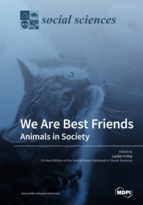We Are Best Friends: Animals in Society
A special issue of Social Sciences (ISSN 2076-0760). This special issue belongs to the section "Community and Urban Sociology".
Deadline for manuscript submissions: closed (15 March 2019) | Viewed by 60239
Special Issue Editor
Interests: animal welfare
Special Issues, Collections and Topics in MDPI journals
Special Issue Information
Dear Colleagues,
Friendships between humans and non-human animals were once dismissed as sentimental anthropomorphism. After all, who could claim to be friends with a being who did not speak the same language? Animals’ emotions were also questioned. However, decades of research on the emotional and cognitive capacities of animals have made it possible to recognize human-animal friendships as true relationships involving mindedness on both sides. Friendships with animals manifest many of the same characteristics as friendships between humans. Both parties understand the other as having interests, preferences, and other aspects of subjective experience. Both enjoy the shared presence that friendship entails, with its moments of intersubjectivity that comes with knowing another being. Both friends develop ways of communicating, apart from or in addition to spoken language.
Having an animal as a best friend often takes the form of companionship understood as the “pet”, but the relationship comes in other forms, too. People who work with animals often characterize their non-human partners as friends. People who work with search-and-rescue dogs, herding dogs, or police dogs develop, and even depend on, the closeness of best friendship. The same holds for equestrians of all sorts, as horses and riders must understand each other’s bodies and movements intimately. In some situations, animals provide the sole source of affection and interaction in people’s lives. Homeless people who live on the streets with animal companions often develop best friendships largely through 24/7 togetherness.
In this light, this Special Issue on humans and animals as best friends seeks to explore the various forms these friendships take. Moreover, it aims to shed light on what these friendships mean for society, broadly construed. In short, how do human-animal friendships, and best friendships, in particular, expand the existing interdisciplinary knowledge of the roles of animals in society?
I encourage researchers from all disciplines and all methodological and theoretical approaches to submit contributions.
Prof. Dr. Leslie Irvine
Guest Editor
Manuscript Submission Information
Manuscripts should be submitted online at www.mdpi.com by registering and logging in to this website. Once you are registered, click here to go to the submission form. Manuscripts can be submitted until the deadline. All submissions that pass pre-check are peer-reviewed. Accepted papers will be published continuously in the journal (as soon as accepted) and will be listed together on the special issue website. Research articles, review articles as well as short communications are invited. For planned papers, a title and short abstract (about 100 words) can be sent to the Editorial Office for announcement on this website.
Submitted manuscripts should not have been published previously, nor be under consideration for publication elsewhere (except conference proceedings papers). All manuscripts are thoroughly refereed through a double-blind peer-review process. A guide for authors and other relevant information for submission of manuscripts is available on the Instructions for Authors page. Social Sciences is an international peer-reviewed open access monthly journal published by MDPI.
Please visit the Instructions for Authors page before submitting a manuscript. The Article Processing Charge (APC) for publication in this open access journal is 1800 CHF (Swiss Francs). Submitted papers should be well formatted and use good English. Authors may use MDPI's English editing service prior to publication or during author revisions.
Keywords
- best friends
- companion animals
- friendship
- human-animal friendship
- human-animal bond
- pets






